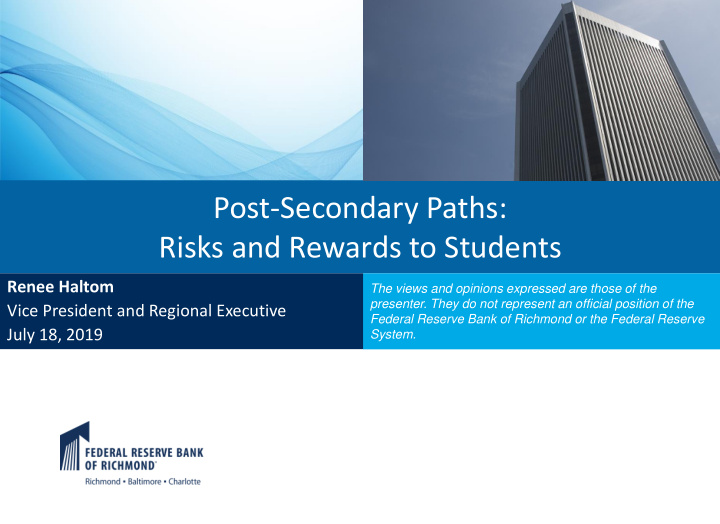



Post-Secondary Paths: Risks and Rewards to Students Renee Haltom The views and opinions expressed are those of the presenter. They do not represent an official position of the Vice President and Regional Executive Federal Reserve Bank of Richmond or the Federal Reserve July 18, 2019 System.
Key Takeaways 4-year college tends to pay for those who complete it. But the important thing is people matching to the best path for themselves. Predicting the jobs of the future is uncertain, but the labor market is increasingly rewarding general, human skills. 2
Why is the Fed interested in education? Standards of Living Economic Growth Productivity Human Capital Education 3
“Human c apital” perspective on post -secondary ed For individuals, post-secondary education is an investment . It’s not without risk ! (e.g., non-completion risk and earnings risk) 4
The earnings payoff to 4-year college has increased over time… Median weekly earnings, workers 25 years and over (2017 constant dollars) $1,600 Bachelor's degree or higher Some college or associate's degree $1,400 High school Less than high school $1,200 $1,000 $800 $600 $400 1979 1981 1983 1985 1987 1989 1991 1993 1995 1997 1999 2001 2003 2005 2007 2009 2011 2013 2015 2017 Source: Bureau of Labor Statistics 5
… and 4 -year college has long inoculated against unemployment. Unemployment rate, workers 25 years and over 16% Less than high school 14% High school Some college or associate's degree 12% Bachelor's degree or higher 10% 8% 6% 4% 2% 0% 1992 1994 1996 1998 2000 2002 2004 2006 2008 2010 2012 2014 2016 2018 Source: Bureau of Labor Statistics 6
4-year college pays on average, but: Occupations Caveat #1: Not everyone earns the average! Sources: Bureau of Labor Statistics; “Invest in What’s Next: Life After High School” (Richmond and SF Feds) 7
4-year college pays on average, but: Caveat #2: You’ve got to finish. Source: Pixabay 8
Great expectations? Many who enroll do not complete any degree within 6 years of completing high school. Expected Attainment No Degree % of No Degree with Loans Certificate 52% 37% Associate’s degree 62% 39% Bachelor’s degree 38% 51% Data reflect survey results from 2004-2009. Source: Avery and Turner (2012) 9
Why so many dropouts? Three dimensions of preparedness Academic Work Knowing ability habits options 10
Society could stand to improve “matching” Some students go to college who “shouldn’t” Overstate own preparedness; understate its importance relative to study effort (Stinebrickner and Stinebrickner, 2012). Some students don’t go to college who “should” Overestimate price (sticker price vs. individual net price) Low-income, high-achieving students do not apply to selective schools, even when such schools would cost them less (Hoxby and Avery, 2012). 11
Richmond Fed resources Free online course for students 12
Community colleges play a crucial role Inexpensive way to test interests and abilities Dropout “option value” ( Trachter, 2015) Relatively quick path to the job market And CCs more nimble to what employers demand Option to transfer to 4-year college Engine for economic mobility 13
Coming “shortage” of trade workers? Caused by: Aging workforce? Overemphasis on 4-year college? Stigma? If so, better info could help If happening, look for prices for those jobs to rise Hard to forecast demand 14
Tradeoffs to vocations It eases youth entry into the labor market (Ryan, 2001 )… … but specialized skills leave workers less adaptable to labor market change (Hanushek, Woessmann, and Zhang, 2011). 15
Jobs of the future: Technology has not affected all jobs equally Shrinking: Routine jobs Manual : machine operator, mechanic, dressmaker Cognitive : secretary, bank teller, retail sales, data entry Growing: Non-routine jobs Manual : waiter, groundskeeper, manicurist, health aids Cognitive : physicians, programmers, managers 16
Labor market has been “hollowing out” Source: Conference hosted by the Richmond and Dallas Feds, May 22, 2019 17
What does this suggest for jobs of the future? Non-routine adaptability “Human” skills increasingly rewarded Question askers, problem solvers, communicators To the extent 4-year school better provides general skills , college payoff likely intact 18
Richmond’s “opportunity jobs” Source: “Opportunity Occupations Revisited” Fee (Cleveland Fed), Wardrip (Philly Fed), Nelson (Cleveland Fed), April 2019 19
Key Takeaways 4-year college tends to pay for those who complete it. But the important thing is people matching to the best path for themselves. Predicting the jobs of the future is uncertain, but the labor market is increasingly rewarding general, human skills. 20
Questions? Renee Haltom Vice President and Regional Executive The Federal Reserve Bank of Richmond (804) 697-8401 Renee.Haltom@rich.frb.org richmondfed.org/research/people/haltom 21
Recommend
More recommend